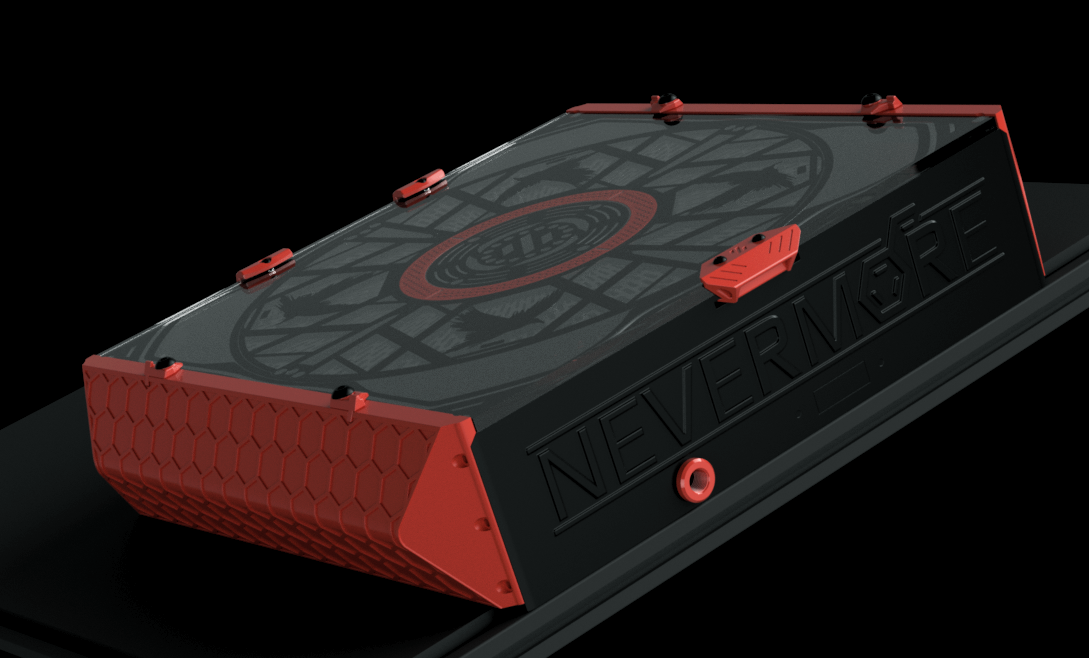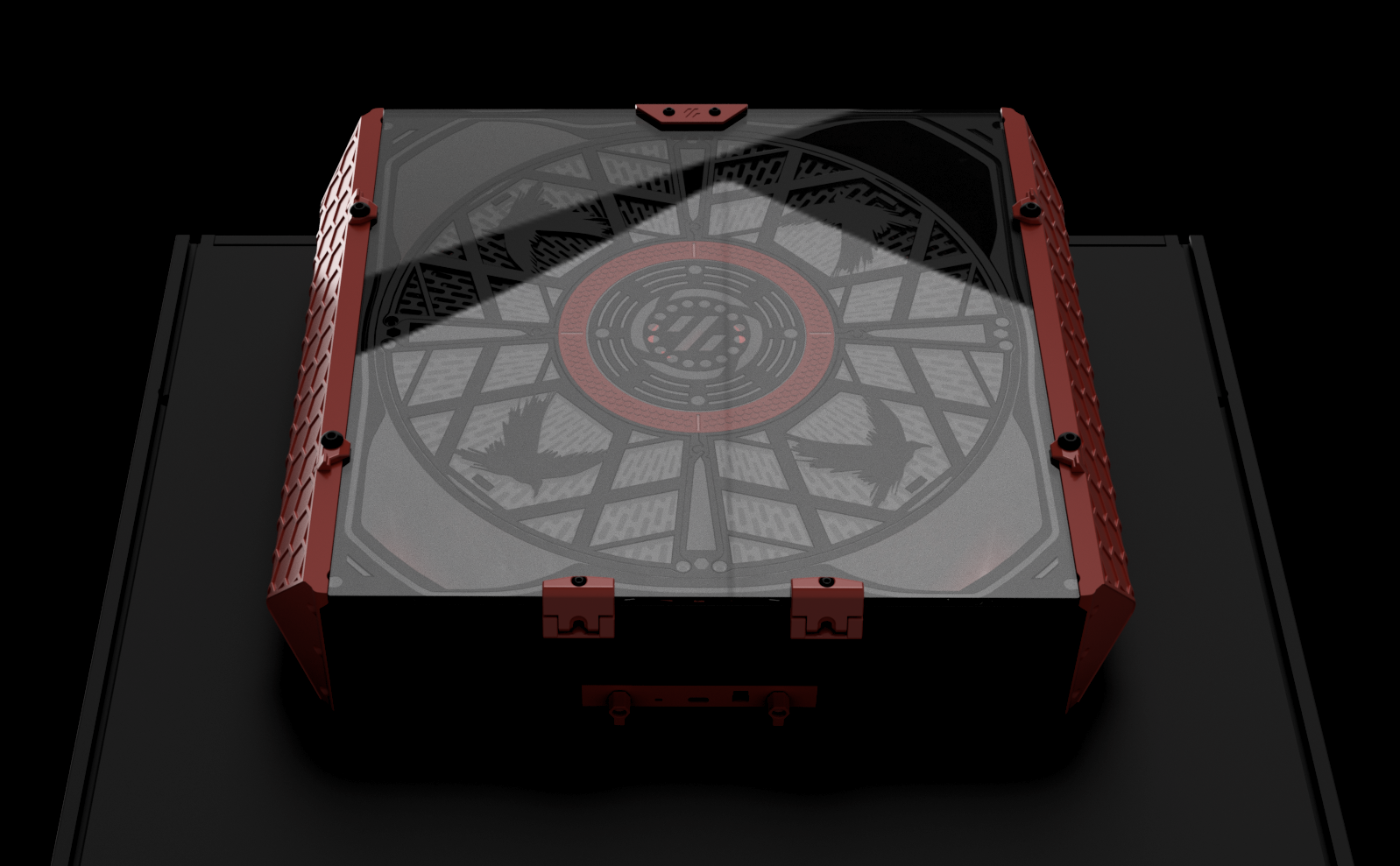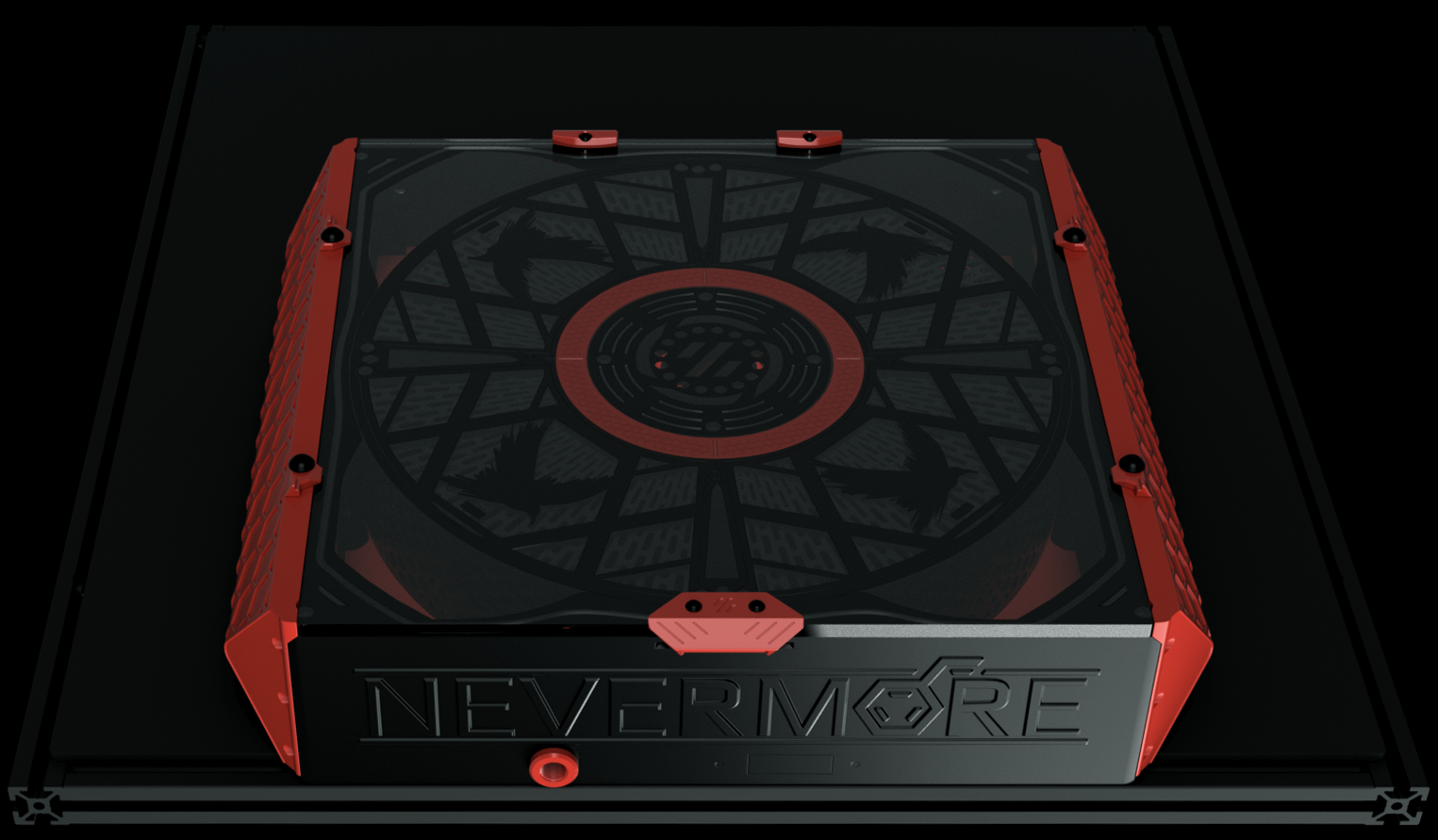Nevermore Stealthmax is the final Max release based on beta feedback, Please check it out!
Max had warping issues with many ABS type materials from the long straight components, which necessitated a frame redesign. This allowed for a built-in exhaust system too driven by the main fan, allowing well-insulated chambers not to overheat when printing PLA and PETG.
300x300mm print bed minimum!
0.2 layers, 0.4 nozzle recommended [0.6+Aarachnae under evaluation]
PRINTING GUIDE:
FRAME:
VERY WARP-PRONE WITH STANDARD ABS! Even if you never have warping issues otherwise, this is at the very edge of plastics cooling stresses. I have printed this successfully with TitanX, other users have had good results with ESun ABS+. As it will never be subject to PETG TG temperatures outside the chamber that can be a good option too. Extra adhesion precautions should be taken (lower z offset with horizontal compensation, nano adhesive, hotter bed or possibly chamber temps, etc). Also dont forget to tape down your flex bed or your flex bed may become the warping point instead.
PANELS
Panels have A LOT of surface area. If you do not use filament that pops off from the bed when cool - a need to flex your bed to remove parts - there is a certain risk that a thin PEI surface (0.15-0.30 mm thicknesses or therabouts) will be pulled off in spots with high adhesion, causing bubbles in your PEI. If you have thin PEI, or any other thin surface that can be damaged, please use a release layer between the print and bed (my simple household go-to for PEI+ABS is some corn starch dissolved in water and evaporated after being brushed onto the hot bed. Parts will release easily and any starch residue on the print or bed just washes off with water).
Carbon Baskets
The unbridged mesh extrusions keeping the pellets inside the filter are usually 0.4mm high and 0.8mm wide. They print best if the width is split in two lines (with some overlap, 0.4-0.46 should do it, check in your slicer) and the height is also split in two layers (allowing the first layer to be printed at a slightly lower extrusion multiplier as per bridging settings, and the second be a regular supported layer).
Other parts The other parts should print like most other prints.
9/9: INSTALL GUIDE ADDED
Table of Contents
Why a Max when the Micro works well? The little bugger is an easy print, nimble, looks great... Why bother making a large unit chewing filament?
Well - there are a few reasons, that may or may not affect your decision on what filter is best for you.
1. We're **LAZY**. A micro cartridge is small and may not last very long. Some will
have filament smell again in two weeks. And while the change is quick and easy,
its still a chore! A Max has 20x the carbon. 20x the carbon lasts...longer.
2. We need **BETTER**. Carbon filtration gets better and better the deeper the carbon
bed. At the small airflow area of a micro, a deep bed quickly chokes air flow.
Ever wondered why a Micro XL cartridge is only 10mm longer than a standard cartridge?
Air flow degrades _that_ fast. The surface area of a micro cartridge is just
above 1000 mm2. A hefty max filter increases that over ten times at the inside
perimeter, and 50 times on the outside perimeter. This means the same powered
fan could move _much_ more air at _less_ pressure drop.
3. We catch **PARTICLES**: 3D printer extrusion creates both VOCs and particles.
The micro focuses on VOCs, as thats what give off the worst smell and has direct
toxic effects, and are difficult to catch once outside of the print chamber.
Yet again, PM particles are among the leading causes of death in the world and
shouldn't be ignored. I've advocated using a regular room-size HEPA for particles
in conjunction with a micro before, but with the Max a HEPA filtration system is
built in. 99+ per cent of particles created by your printer will be removed
every pass and you wont add dirty air to your room or lungs.
4. We need **COOLER**: 3D printing and 3D printing filtration require different things.
For instance, we _love_ to have a 60C chamber for less ABS warping. At the same
time, with increasing heat, the VOCs get more heat energy and desorb from the
carbon. Sensor testing has shown that turning on a well used carbon filter can
_increase_ chamber VOCs. Anything above 50C is generally not good for bads stuff to
stay attached to the carbon. And while the micro has been shown to work even at
80C intake air under a heated bed, it most definitely decreases the time between
carbon changes a lot! Having the filter unit outside of the printer allows for the
carbon to be a few degrees cooler than the printer. That does much for longevity.
5. We haz to needz **TECHz**: More space for cooler gadgets. Ever wondered when
its time to swap carbon? Well, on the max you could add VOC sensors to both intake
and exhaust and measure how well the filter is doing its job! Thanks to Dr Dave
there are even data on which sensors reliably detect the aromatic VOCs we strive
to catch (a lot of sensors hardly detect extrusion VOCs at all as they are intended
for other applications). I've chosen to divide the project into a Basic version
with just HEPA+carbon+fan, but entirely upgradeable to the Pro version
including VOC sensors (temp, humidity, filter efficiency), LED/Screen
/Controller board, servo carbon sealing for (optimal carbon longevity with no
room VOC carbon depletion) and a 4010 exhaust (negative pressure+vent
control).
7. Less **NOISE**: Lets face it. A high powered 5015 creates some noise. Two creates
even more. By increasing the size of the carbon filter, decreasing pressure drop,
we can run the filter fan slower while still getting the same air flow. We can
run the fan at a higher rpm:s and clean the chamber in a jiffy as well.
Convinced? Well, then the Max is for you!
You're ready to build a Nevermore? Cool! The New Max is a lot simpler to assemble compared to the first version!
For the sourcing guide, details and material list please check this out: BOM
Instead of ultra thin bolts, m3 lap top screws seems to work as well and are readily available (https://www.ebay.com/itm/185540026013?var=693379492797)
The installation guide is under development, the alpha presentation should take you 90% of the way: Installation Guide
The Voron nevermore Air Filter was modelled in Fusion 360.
At the end of the day, a fresh single-pass filtered exhaust (at brand new) has perhaps 70% VOC removal efficiency while still exhausting 30% of the nasty into the air you breathe. A recirculation filter achieving four passes at worn-in 50% efficiency could still remove 94% of the bas stuff. Or 99% at six passes!
The number of passes you get all depends on how well you can seal your build chamber. The better sealed the chamber, the less room VOCs will circulate the carbon and deplete the filter too (VOCs from onions, wall paper or farts might not be as unhealthy as melted plastics VOCs, but they block space in the carbon all the same).
Some will have a hard time achieving a good chamber seal, which creates the biggest drawback of recirculation filters - they're air flow neutral. Meaning, as nothing pulls air into the chamber, air can diffuse freely to the outside through any remaining gaps. And that air could be zero per cent cleaned...
To both have the cake and eat it (yes you can!), a Max can incorporate a 4010 exhaust fan, that is used to keep a slight negative pressure inside the chamber - air will still just get pulled into the chamber through any remaining cracks, not leak outside. Don't ramp it up high, its meant to just barely evict air so that the majority of air flow through the filter is still recirculated.
Air evicted through the exhaust will at least have passed through the carbon filter, dust-filter and HEPA filter at least once (hopefully many more times) - so its a good security measure to have if you don't want to bet on your chamber being hermetically sealed.
Yup, but aside from being one-pass, regular mesh carbon filters mainly consists of...mesh. And active carbon sprinkle - miniscule amounts, not meant to be used 24/7 in a 3d printer.
Just running regular air through a mesh filter will still deplete it in weeks (carbon can't opt to just bind the nasty stuff). Filter exposed to air depletes it too, in time. Friggin' everything depletes carbon. Thats why we need more.
The Nevermore has a kilo, or two pounds, of active carbon. Not single-digit grams. And its can be sealed off from the surroundings, so when its not running, its not depleting. Any off-gassing between prints will likewise be kept inside the filter! And when is does run, it has a lot of VOC binding capacity! At least a hundred times more compared to a generic solder fume carbon mesh filter.
This is the filter for the low maintenence crowd (who still want to be safe).
If you live alone - not impacting other people – and feel that way, this filter is not for you!
After all, you’re perfectly allowed to smoke two packs a day or become a opposition politician in Russia too, even though it’s probably not optimal for your health. And on an individual level one can never be sure what the health effects will be, if any - the oldest person ever used to smoke until she was 118 years or so…
But speaking of what we do know, we can say for sure that:
The WHO:s International Agency for Research of Cancer (IARC) classifies chemical compounds based on the known evidence of human carcinogenics, into four classes (carcinogenic, probably carcinogenic, possibly carcinogenic or not classifiable as carcinogenic to humans).
Most chemicals fall into the last category, but in the known carcinogenic groups we find several known 3d printer byproducts:
o Benzene
One of the main fumes from ABS printing. 3ppm regarded as safe, whereas up to 280 ppm of VOCs are produced ABS printing every hour in a small space. Proven to cause different leukemias, and suspected of causing a multitude of other cancers. Female workers in a shoe factory exposed to 40ppm for a long time had a hundredfold higher risk of dying from breast cancer, for instance. Class 1 carcinogenic.
o Styrene
Main pollutant in ABS fumes, recently upgraded from possible to probable carcinogenic based on mounting evidence of connection with a close to tripled risk of different leukemias.
o Butadiene
Another component of ABS printing, and the reason why styrene didn’t get the carcinogenic label for so long (as both are ABS byproducts it was long impossible to know if a cancer type was due to butadiene or styrene. Butadiene is also a known cause and/or cofactor in cardiovascular disease, so you might get your heart attack or stroke a few years earlier by breathing it in for a long time.
Other knowns:
• What creates the most particles/VOCs from plastics handling is heated extrusion.
• Injection molding, vacuum forming and other common industrial methods creates less air pollutants due to less melted plastic surface per kg with direct air/oxygen access/airflow.
• 3D printing extrusion takes this to another VOC creation level, as you’re extruding thin layer by thin layer, not trapping any of the extruded melted material from access to oxygen or airflow. Thus, per kilogram of product, it’s the most particle and VOC generating plastic process there is.
• Home 3d printers are often used in places without industrial ventilation or industrial wet scrubbing. Indeed, a recent study showed that levels of VOC carcinogenics in plastics recycling plants using heated extrusion processes were mostly within safe limits. However, in surrounding residential homes of those safe-to-work plants, VOC levels were up to 42 times the safe limits and consisted of the ventilated byproducts from the plastic plants, due to lower ventilation requirements in homes. The study showed a clear increased lifetime cancer risk, even for the workers in the plants.
This is a short list of some key knowns, and only address the most common ABS fumes. Other materials have different VOCs. PETG for instance, releases Toluene, Acetaldehyde, Formaldehyde – all of which are known health hazards. Regular PLA and Nylons without additives are usually safer, but still release lower levels of acetone, methyl-methacrylate, and iso-butanol (PLA) and Propylene Glycol and Cyclopentanone (Nylon). Not all fumes are created equal.
Please contribute! I'd like to incorporate VOC sensors, making the filter smart (running on low-noise mode at an acceptable VOC level, then ramp up at the end to clean more thoroughly before doors open).
Distributed under GNU General Public License version 3.0 (GPLv3)
0ndsk4#5933 - (http://discord.com/user/0ndsk4#5933)
Nevermore: https://github.com/0ndsk4/VoronUsers/tree/0ndsk4/printer_mods/0ndsk4/Nevermore_Air_Filter


